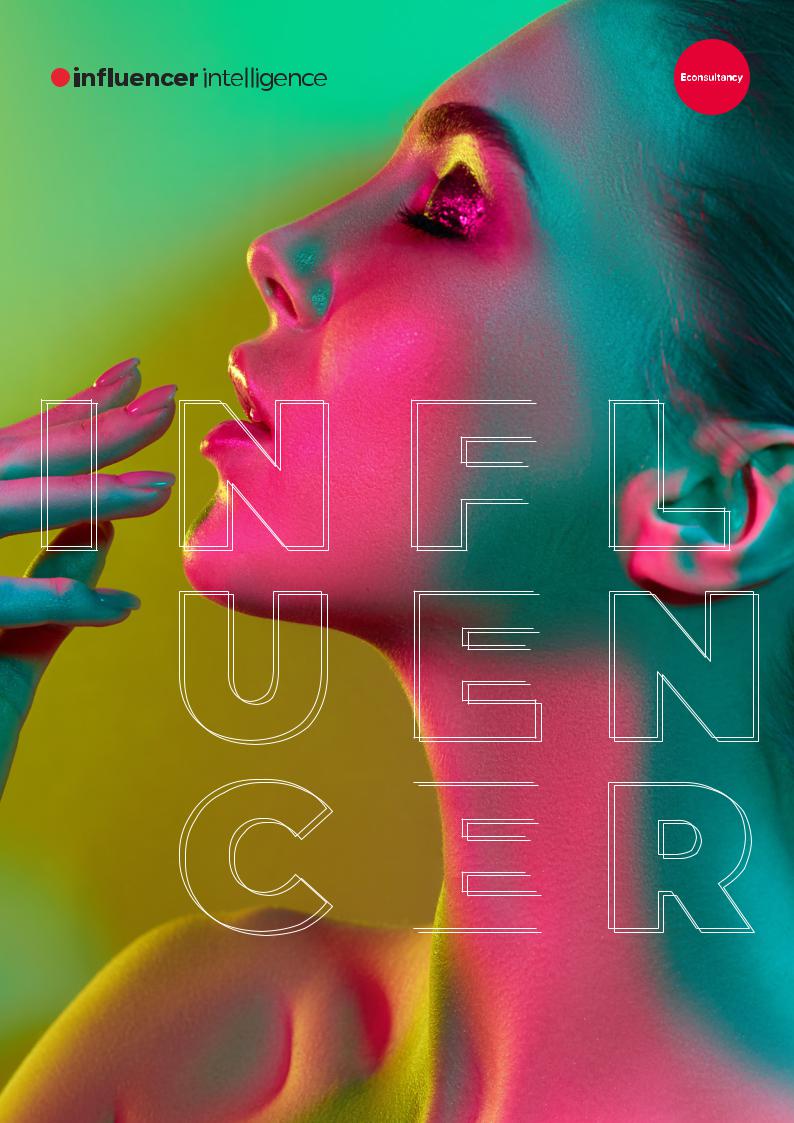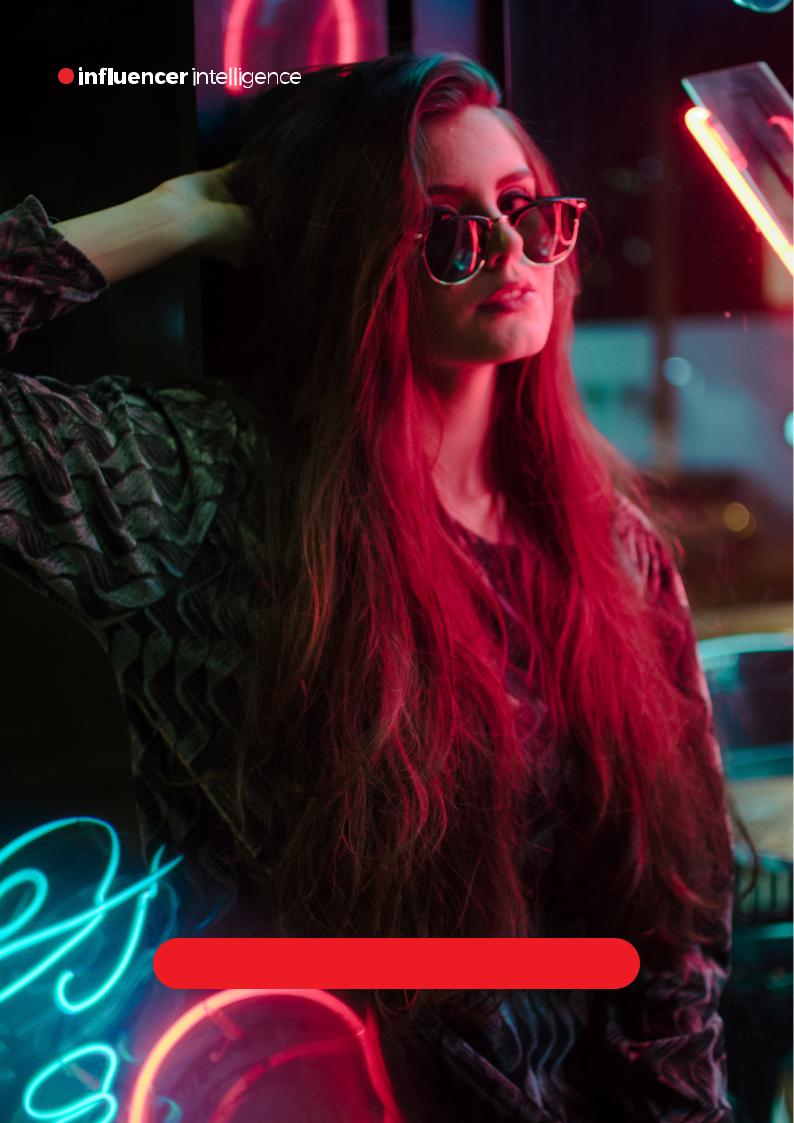
АГРОЗЕМЛЯ экономика
.pdf
vk.com/id446425943
I N F


 L U E
L U E


 N C E
N C E






 R
R
M A R K E T I N G 2 0 2 0

vk.com/id446425943
2
A B
O UT
We are a powerful data intelligence tool that combines the knowledge and insights you need to deliver a successful celebrity and influencer marketing strategy. From emerging talent to mainstream taste-makers, we help businesses worldwide to discover and connect with only the most relevant talent
Published November 2018
All rights reserved. No part of this publication may be reproduced or transmitted in any form or by any means, electronic or mechanical, including photocopy, recording or any information storage and retrieval system, without prior permission in writing from the publisher.
Copyright 2018 Centaur Communications Limited
Celebrity Intelligence is part of Centaur Media plc.
Influencer Intelligence UK |
Influencer Intelligence USA |
4th Floor, Wells Point |
350 7th Avenue, Suite 307 |
79 Wells Street |
New York, NY 10001 |
London W1T 3QN |
United States |
United Kingdom |
Telephone: |
|
|
Telephone: |
1-800-680-5773 |
UK 020 7970 4299 |
|
influencerintelligence.econsultancy.com |
|

vk.com/id446425943
METHODOLOGY
This research report is published by Influencer Intelligence, in association with Econsultancy, and explores how the influencer marketing landscape has evolved in 2018, and looks at how well collaborations are currently being executed. As the title of the report suggests, it also considers the future of influencer marketing, and the challenges and capabilities that must be addressed for it
to be sustainable.
There were 1,173 marketing specialists who responded to the research request this year, which took the form of an online survey. Respondents included in-house brand marketers, agencies, consultants and talent, across a broad range of industry sectors. In addition, 500 consumers aged 18 to 34 years were surveyed, in the UK and the US, to gauge their attitudes and perceptions of digital influencers. Detailed breakdowns of the respondent profiles are
included in the Appendix of the report.
If you have any questions about the research, please contact Influencer Intelligence’s Senior Content Marketing Manager, Priyanka Mehra-Dayal by emailing
priyanka.mehra-dayal@centaurmedia.com
CONTRIBUTORS
The report features qualitative interviews from a wide range of industry experts including brands, agencies, influencers and consultants. Interviews were carried out over the phone in August and
September 2018. Contributors include…
Bexy Cameron |
Sarah Evans |
NATASHA HULME |
Ollie Thomas |
Aaron Brooks |
Head of Insight |
Head of Digital at Bottle PR |
Senior Strategist |
Managing Partner |
Co-Founder |
Amplify |
|
Beauty SEEN |
Beyond Talent Global |
Vamp |
Emma Usher |
Natasha Mensah Benjamin |
Lucy Lendrem |
Suri Singh |
Dee Mehta |
Company Director |
Managing Partner |
Head of Talent UK at |
Influencer Expert |
Marketing Manager |
RunRagged Media |
Beyond Talent Global |
Gleam Futures |
ITB Worldwide |
Ananya |
|
Ella Catliff |
Marianne Fakinos |
Joseph Harper |
|
|
Head of Communications at |
Senior Influencer and |
Social Media Manager, |
|
|
The House of Luxury and |
Partnership Manager |
UK & Ireland |
3 |
|
Founder of La Petite Anglaise |
TMW Unlimited |
Kellogg’s |

vk.com/id446425943I N
D E X
06
EXECUTIVE SUMMARY
09
14
17
INTRODUCTION
10 WHERE IS THE INDUSTRY NOW?
CASE STUDY: CONVERSE’S ‘YOUNG
AND LACED’ PROGRAMME INVESTS IN A NICHE POCKET OF YOUTH CULTURE
15 KEY
TRENDS
CASE STUDY:
MANGO GIRLS
18 CASE STUDY:
H&M SPORT MAKES AMBASSADORS
OF NICHE GLOBAL
SPORTS ENTHUSIASTS
4

vk.com/id446425943
22 CASE STUDY:
JEWELLERY BRAND ANANYA FINDS
SUCCESS WITH AUTHENTIC, UNPAID INFLUENCER COLLABORATIONS
26 CHALLENGES
32 CASE STUDY: KELLOGG’S: JUSTIFYING
INVESTMENT WHEN THERE IS
NO DIRECT LINK TO PURCHASE
33 MEASURING SUCCESS
37 WHERE DOES THE INDUSTRY NEED TO BE IN 2020?
41 CONCLUSION
42 REFERENCES
5

vk.com/id446425943E X E C
U T I V E
S U M M A R Y
KEY FINDINGS
Digital influencers have swayed purchase
decisions for the majority of millennials
61% of consumers, aged 18 to 34, have at some point been swayed in their decision-making by digital influencers, the consumer survey finds.
This consumer group is a discerning one having largely grown up with social media and is often the first to notice when an influencer has sold themselves out or failed to disclose a commercial relationship. It stands to reason that within the survey of industry marketers, 56% admit that the changing expectations from a rising digital-born generation of consumers is proving the biggest driver of change within their influencer marketing programmes. Amidst growing rumours of a backlash against influencer culture, how this younger generation perceives influencers, and permits their opinions and choices to be shaped by them, will ultimately determine the sustainability of influencer marketing moving forward.
Confusion continues to plague disclosure guidelines
Brands are fully aware that consumer trust in influencer content is eroding, and 64% of marketers feel that drastic action to prove transparency is critical. While the Advertising Standards Authority in the UK (ASA) and Federal Trade Commission (FTC) in the US, set guidelines for influencers and have begun to take a harder line on individuals who are not properly disclosing their commercial brand relationships, industry experts interviewed say there is a strong case for more clearly defined rules that are not so open to interpretation.
|
100% |
of marketers agree that ‘relevance’ is the |
|
most sought-after attribute in influencers |
|
|
Industry experts agree unanimously (100%) on the importance |
|
|
of collaborating with influencers whose following is relevant |
|
|
to the brand. Three quarters of industry respondents say |
|
|
influencers should already be a fan of the brand, for example, |
|
|
to prove their relevance. Many of the experts interviewed for |
|
|
the report championed the concept of brands supporting |
|
|
influencers who are already embedded with the brand and |
|
|
have been loyal supporters for some time, so that their first |
|
|
posts are organic and unpaid for. This, experts claim, will |
|
|
ensure that the influencer is proud and passionate about the |
|
6 |
content that they create on behalf of the brand. |
|
61% of consumers say micro-influencers produce the most relatable content
56% of marketers questioned say that micro-influencers are more cost-effective for them to work with than top tier talent, and 55% also believe they have a better connection with their target audience. When it comes to analysing the appeal of micro-influencers, 61% of consumers believe they produce more relatable content. Furthermore, US consumers particularly value the transparency of this segment of talent
(44%), significantly more than UK respondents (26%).
Proving the ROI of individual influencers is a big challenge for 84% of marketers
A resounding 84% of marketers agree that being able to demonstrate the ROI of influencer marketing will be critical to its future. Yet despite this, 31% say influencer marketing is peripheral to their digital marketing ROI calculations, and additionally proving the ROI of individual influencer collaborations is also cited as the greatest ongoing challenge
(alongside identifying the best talent to work with).
90% of marketers say authenticity is critical to
the future of influencer marketing
More than two-thirds (68%) of industry respondents say that authenticity and transparency is key to influencer marketing success. Experts interviewed for this report stressed the need for due diligence in selecting an influencer to work with, to ensure they are not only a credible match for the brand and their audience, but also the campaign in question.
Contract terms are also changing to reflect the gradual rise in longer-term, organic and more meaningful partnerships that are being forged between brands and influencers. Only 8% of survey respondents claim that they are engaging influencers on a one-off post basis. Above all, 90% of industry respondents say that brands need to take authenticity and transparency more seriously, for it to be sustainable over the long term. Consumer attitudes are similar, with 61% expressing a preference for influencers who create authentic, engaging content.

vk.com/id446425943
More than half of brands are searching for |
|
influencers manually |
|
‘Identifying talent’ is cited by marketers as the biggest challenge |
|
in influencer marketing, currently. One of the main reasons |
|
for this is that just over half (54%) of respondents say they |
|
are continuing to search for influencers manually, via social |
|
media platforms and forums. Experts interviewed for the report |
|
stressed the need for the identification process to include a |
|
360-degree analysis of influencers, benchmarking them, looking |
|
at their audiences and their personality archetype, all through a |
|
combination of manual due diligence and data-driven insights. |
|
‘Fake followers’ ranks as number one concern |
|
within influencer marketing |
|
‘Fake followers’ ranks as number one concern with influencer |
|
marketing. Earlier this year, Keith Weed, Unilever’s CMO, took |
|
the stage at Cannes to expose the current state of influencer |
|
marketing, which he argued is plagued with transparency and |
|
authenticity issues. He claimed the industry should take a |
|
stand against fake or bought followers and refuse to work with |
|
influencers adopting such practices. “We need to take urgent |
|
action now to rebuild trust before it’s gone forever,” he said. |
|
It is therefore unsurprising that a few months on, industry |
|
respondents rank ‘fake followers’ as their number one concern |
|
with influencer marketing. Fraud detection is a key challenge |
|
which the entire industry needs to take a stand against. |
|
Engagement is the number one benchmark |
|
for success |
|
85% of marketers say engagement data, such as comments |
|
and content shares, is the biggest metric of success for |
|
influencer marketing. What was once an industry that measured |
|
its success according to big follower numbers and volume of |
|
‘likes’, has matured significantly to focus on how audiences are |
|
reacting to and interacting with influencer content. |
|
Overall, brands are becoming better educated in the ways |
|
available to them to measure the success of their influencer |
|
collaborations, and the expert interviews carried out for this |
|
report reveal that many are now having the confidence to |
|
request analytics from the influencer directly. |
7 |

vk.com/id446425943
Discover.
Connect.
Influence.
The only celebrity and influencer marketing tool you need
Learn more at
influencerintelligence.econsultancy.com
8

vkINTRO.com/id446425943
DUCTION
2018 has been the year that influencer marketing has exploded, while simultaneously coming under the greatest scrutiny. Initially heralded as the future of digital marketing and thought to have the potential to challenge more traditional forms of celebrity marketing, the past 12 months have exposed chinks in the armour, raising questions over the long-term sustainability of influencer marketing.
Articles have surfaced claiming influencer marketing is dead, and a couple of high-profile investigations by the Competition and Markets Authority (CMA) and Federal Trade Commission (FTC) into whether top tier influencers have been endorsing products without disclosing their commercial interests, have cast doubt over the credibility of digital talent, with critics claiming their influence has also begun to wane.
To add fuel to the fire, Keith Weed, Unilever’s CMO, took the stage at Cannes this year to expose the current state of influencer marketing, which he argued is plagued with transparency and authenticity issues. He called for a three-pronged approach to influencer marketing in which misleading engagement, dishonest practices and a lack of transparency need to be fixed.
“We need to take urgent action now to rebuild trust before it’s gone forever,” he said.
Mistakes have clearly been made, by influencers and brands alike, and significant challenges still exist; but to tarnish the entire industry with the same brush is unjustified. There was a period of education as there would be with any new form of marketing, and experts interviewed for this report agree that we have arrived at a place where brands are beginning to do influencer marketing properly. Bexy Cameron, Head of Insight at brand experience agency Amplify and an expert on British youth culture, shares: “How we are working with influencers is changing: the industry isn’t dying but we need to get smarter about how we do influencer marketing and work with people who have expertise, who are relevant and who are already embedded within the brand. Brands need to stop looking at just reach and start considering all of the other parts of influence.”
For a few years brands gravitated towards working with the biggest names and largest followings in the industry, for understandable and valid reasons: after all, that is what has characterised celebrity marketing for many years, with proven success. But diversity is on the rise and brands are seeing the benefits of working with a range of influencers, particularly micro-influencers. Approximately 6 in 10 of the digital marketers surveyed for this report claim the purpose influencer marketing serves for their business has changed in the last 12 months (see Fig. 4 below), with the younger generation of consumers being the biggest driver of change (see Fig. 3). Young people have come to more firmly reject the way that influencer marketing has been done over the past few years and are instead demanding higher levels of authenticity and relevance. “In its infancy, influencers
were engines for product promotion, but today, we are crafting collaborative brand and product narratives through influencer content partnerships. We’re looking for influential voices with interesting stories and points of view for brands,” shares Natasha Hulme, Senior Strategist at Beauty SEEN. “We are taking learnings from the past and understanding how to balance paid endorsements with organic advocacy.”
A simple example illustrates this point well. Grime artist Stormzy, and singer and actress Rita Ora, have both had collaborations with Adidas. Stormzy has been a loyal follower of Adidas for years, dating back to well before he found fame. “You could scroll back five years on his social stream to see him wearing Adidas with his crew - he was very embedded with the brand, because he loved it,” says
Bexy Cameron, Head of Insight at Amplify. Rita Ora, on the other hand, has put out several collections with Adidas Originals, but during that time she also shared pictures of herself wearing Fila and Reebok, among other athletic brands. “Rita Ora got pulled in to do a campaign with Adidas and she had a much bigger reach at the time than Stormzy, however two weeks beforehand her audience had seen her wearing Sketchers. That says to her audience she is there for a brand activation, rather than because she is in embedded with the brand, and when young people are so savvy you can’t afford to make slip-ups like that,” says Cameron.
But the tide is turning, and contrived commercial partnerships are waning in favour of genuine, organic brand tie-ups where there is already some natural affinity or advocacy. Lucy Lendrem, Head of Talent UK at Gleam Futures, shares: “We are seeing a lot of beauty brands only engaging commercially with talent who naturally endorse the brand, i.e. they have to be fans of the brand. In the early days there was a lot of paying people who didn’t already talk about the brand in order to increase reach, but increasingly that is becoming a must-have for brands, which means the talent who are most passionate about a brand end up working with them commercially, and that is only a good thing.”
As we look ahead to 2020, the future of influencer marketing, like any marketing strategy, will be subject to changing trends, audiences, and technologies. The wider the landscape gets, the harder it will be to navigate, and the experts interviewed for this report agreed more challenges are coming. For influencers also, the barriers to entry are becoming higher, which is making it harder for rising talent to break through. This report will consider the opportunities and threats shaping the future of this increasingly critical segment of digital marketing. Through qualitative expert interviews and bespoke survey data collected from both industry marketers and consumers within the UK, US and globally, it will seek to clarify the capabilities and approaches required to make influencer marketing a sustainable investment for brands, both now and in the future.
9

vk.com/id446425943
WHERE
IS THE
INDUSTRY
NOW?
On Instagram alone, influencer marketing is now a $1bn industry, and this figure is rising steadily, predicted to reach $2bn by 2019.01 Recent new features such as Instagram Stories, Live and Gallery, along with the new paid partnerships tag are all designed to benefit brands and influencers alike, while drawing audiences in deeper.
Most household brands have found ways to partner with Instagram influencers, and particularly in the fashion, beauty and lifestyle sectors. However, a critical finding of the survey of digital marketers, carried out across a wide variety of business sectors, is that 29% have never worked with influencers, and a further 35% have an influencer marketing strategy that is less than two years old (see Fig.1 below). A mere 14% say they have worked with digital talent for more than five years. This suggests that influencer marketing isn’t for everyone yet, and that more than half of marketers are still to see its full benefits.
Figure 1
How long have you worked with social media influencers as part of your brand communications strategy?
|
|
|
|
|
29% |
|
|
|
21% |
|
|
14% |
|
13% |
|
14% |
|
|
|
|
|
|
|
|
9% |
|
|
|
|
+5 |
4-5 |
3-4 |
1-2 |
Less |
I don’t |
Years |
years |
years |
years |
than 12 |
work with |
|
|
|
|
months |
influencers |
10
